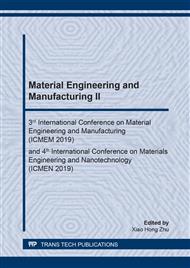[1]
Wu Jiuhui, Ma Fuyin, Zhang Siwen. Application of Acoustic Metamaterials in Low-frequency Vibration and Noise Reduction [J]. Journal of Mechanical Engineering, 2016, 52(13): 68-78.
DOI: 10.3901/jme.2016.13.068
Google Scholar
[2]
J. B. Pendry, D. Schurig and D. R. Smith. Controlling Electromagnetic Fields [J]. Science, 2006, 312(5781): 1780-1782.
DOI: 10.1126/science.1125907
Google Scholar
[3]
Leonhardt U. Optics Conformal Mapping [J]. Science, 2006, 312(5781): 1777-1780.
DOI: 10.1126/science.1126493
Google Scholar
[4]
S. A. Cummer and D. Schurig. One Path to Acoustic Cloaking [J]. New J. Phys., 2007, 9: 45.
DOI: 10.1088/1367-2630/9/3/045
Google Scholar
[5]
V.G. Veselago. The Electrodynamics of Substances with Simultaneously Negative Values of and [J]. Soviet Physics Uspekhi, 1968, 10(4): 509-514.
DOI: 10.1070/pu1968v010n04abeh003699
Google Scholar
[6]
J. B. Pendry, A. J. Holden, W. J. Stewart and I. Youngs. Extremely Low Frequency Plasmons in Metallic Mesostructures [J]. Physical Review Letters, 1996, 76(25): 4773-4776.
DOI: 10.1103/physrevlett.76.4773
Google Scholar
[7]
J. B. Pendry, A. J. Holden, D. J. Robbins and W. J. Stewart. Magnetism from Conductors and Enhanced Nonlinear Phenomena [J]. IEEE Transactions on Microwave Theory and Techniques, 1999, 47(11): 2075-2084.
DOI: 10.1109/22.798002
Google Scholar
[8]
Gao Dongbao, Zeng Xinwu. Layered Elliptical-cylindrical Acoustic Cloaking Design Based on Isotropic Materials [J]. Acta Physica Sinica, 2012, 61(18): 260-267.
DOI: 10.7498/aps.61.184301
Google Scholar
[9]
Shen Huijie, Wen Jihong, Yu Dianlong, Cai Li, Wen Xisen. Research on a Cylindrical Cloak with Active Acoustic Metamaterial Layers [J]. Acta Physica Sinica, 2012, 61(13): 230-237.
DOI: 10.7498/aps.61.134303
Google Scholar
[10]
Zhang S, Yin L, Fang N. Focusing Ultrasound with an Acoustic Metamaterial Network [J]. Physical Review Letters, 2009, 102(19): 194301.
DOI: 10.1103/physrevlett.102.194301
Google Scholar
[11]
Li Y, Liang B, Tao X. Acoustic Focusing by Coiling up Space [J]. Applied Physics Letters, 2012, 101(23): 036609.
Google Scholar
[12]
Y. Lipman, D. Levin. Derivation and Analysis of Green Coordinates [J]. Computational Methods & Function Theory, 2010, 10(1): 167-188.
DOI: 10.1007/bf03321761
Google Scholar
[13]
A. N. Norris. Acoustic Cloaking Theory [J]. Proceedings of the Royal Society A: Mathematical, Physical and Engineering Science, 2008, 464(2097): 2411-2434.
DOI: 10.1098/rspa.2008.0076
Google Scholar
[14]
Y. Li, X. M. Wang, Y. L. Mei*. Acoustic Characteristics of 3-D Membrane-embedded-type Metamaterials, Proceedings of the International Conference on Computational Methods (ICCM2017) 2017, Guilin, Guangxi, China, 914-925.
Google Scholar


